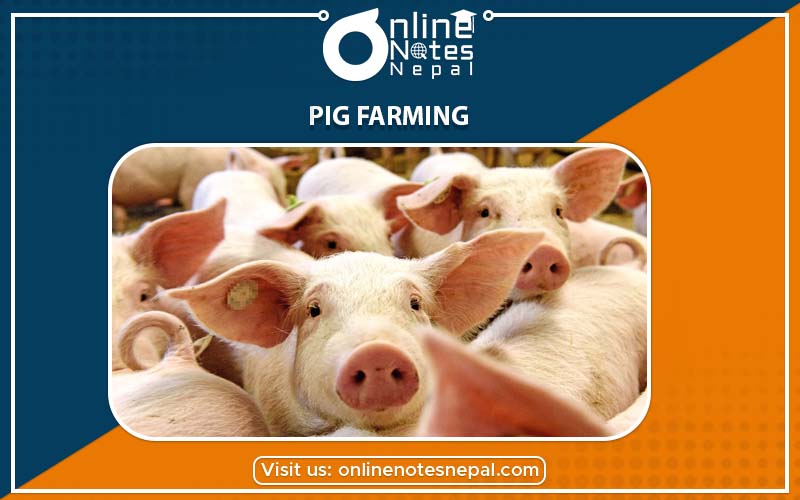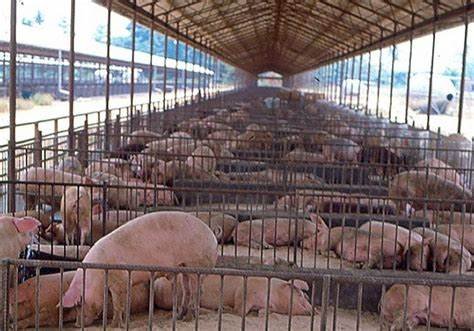Published by: BhumiRaj Timalsina
Published date: 28 Jan 2022

Pig farming is a very profitable business in Nepal. It can be on a micro scale or on a large scale for commercial farming. It supports the livelihood of poor people in rural areas. Pigs are kept mainly for meat production. There are two types of breeds available, which are:
The production of pig depends on different factors such as feeding, control of diseases, their breeds, and the overall management of the firm.

A balanced diet means providing all kinds of nutrients required for them. Pigs are the non-ruminant animal and cannot synthesize any of the nutrients in their stomach. Carbohydrates and fats are required for energy and proteins, vitamins, minerals, and water are required for growth, maintenance and vitality. They get all nutritions from varieties of food products derived from plant and animal sources.
They get fed mostly by corn and soybean meals with a mixture of minerals and vitamins added to the diet. They are also given vegetable peels, bakery wastes, kitchen wastes, etc. They also eat vegetables, roots, fruits, flowers, grass, grains and seeds. They also find some food from pasture land. But, they depend more on readymade feed or in the food that we provide. The food we provide should contain right proportion of proteins, minerals, and energy foods. Adult pigs consume 3 to 5 gallons of water per day. The success and failure of pig farming mostly depend on the feeding process.
To prepare a balanced diet for pigs, you must provide all kinds of nutrients from the variety of the food sources during feeding. Pigs are non-ruminant animals. Locally available sources of these nutrients are as follows:
Carbohydrates and Fats: Carbohydrates are the main source of energy. The main source of carbohydrate is rice, maize, barley, and wheat.
Minerals: Minerals are important for the body to stay healthy. The sources of minerals are common salt, bone meal, oyster cells, and readymade mineral mixtures. Calcium and phosphorous is required in a large quantity.
Proteins: Proteins are large, complex molecules that play many critical roles in the body. The main sources of proteins are soybean, mustard seeds, leguminous crops like cowpeas, grams, lentils, peas etc.
Vitamins: Vitamins are organic compounds which are needed in small quantities to sustain life. The vitamins can be obtained from fruits and green vegetables.
Water: Fresh water should be provided as much as they need.
Particular selection and the combination of food sources should be made to prepare a balanced diet. Apart from the sources of nutrients, preservatives, flavoring and coloring agents, antibiotics, enzymes are also added which may also be found on the market.
In exotic breed such as Hampshire, Landrace, Yorkshire, two types of the breeding systems are followed.
Cross breeding are practiced for commercial pork production. After sow is mated, its gestation period lasts for 113 days in average. Gilt becomes mature enough at five or six months of age for breeding and heat period starts and remains active for 3 days maximum. Pigs come into heat every 21 days.
10 to 12 piglets are born at a single time. Pig farming is a great source of income. Apart from meat, their bristle is used in industries to make brushes. Their disposal is used to prepare manure.
Appropriate maintenance of technical and financial record is very important for production management. It’s better if the record is prepared monthly as well as annually. Entire ledger should be up to date related to:
Anthrax: It is a bacterial disease. It is highly communicable disease and may affect human beings. It is controlled through vaccination. When pigs get an infection of anthrax, they do not eat and their body temperature goes around 108oF.
Foot and Mouth Disease: It is a viral disease. It is also highly communicable disease. Himex ointment is a treatment for the infected pigs. Infected pigs salivate and feel difficulty in walking. Pigs should be vaccinated at a 4-month interval.
Swine Fever: Infected pigs' body temperature goes around 106oF. Constipation is seen in the initial stage and finally diarrhea with blood strains. Running nose appears with mucus and blood. Pigs should be vaccinated annually to prevent this disease.
Parasites: Parasites are living things that use other living things - like the pigs' body - for food and a place to live. They can get them from contaminated food or water. There are two types of parasites; external and internal. External parasites can be controlled by sanitary management. But, the internal parasites like tapeworm, threadworm, roundworm, and trichuria are more problematic. It is advisable to consult veterinary doctors.
There are other diseases like brucellosis, swine flu, nematodes, cestodes and so on. Hygienic environment should be maintained for proper sanitation and prevention. In order to control any diseases and parasites, spray disinfectants two weeks before the due date of birthing.